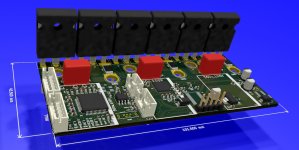maxxximatoze
1 mW
- Joined
- Apr 4, 2019
- Messages
- 12
shaman said:Yes that's the one I've looked at to use. I've already mentioned that in this thread.
I agree that a 12 TO-247 is possible. It would just be a bit expensive. You're right that the energy output would be big for it's size. I may design one anyway.
Yes, it would be certainly powerfull. Maybe with TO-247 mounted under the main PCB like this https://obrazki.elektroda.pl/2050230600_1391595843.jpg to have minimal footprint and easy mount on heat sink with some screws, with the control logic and drivers on the upper side to limit distance between drivers and fets, with a bunch of caps and some copper bus bar (or thick copper wires to keep it cheap). What do you think ?


